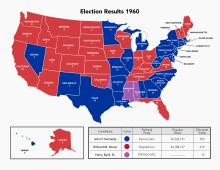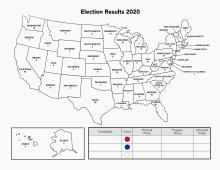Download this lesson plan, including handouts, as a pdf.
Overview
Goals/Rationale
- Observe and analyze voting patterns in US presidential elections
- Engage students in current election
- Read and interpret data
Essential Question:What makes voting patterns change over time?
Objectives
Students will:
- analyze 1960 election results to identify voting patterns, for example, by region.
- record current election results.
- compare the results and identify changes in voting patterns.
Preparation
Prior Knowledge and Skills
It is helpful to have some knowledge of the Electoral College (see Additional Resources.)
Historical Background and Context
“He’s too young to be president.” “He doesn’t have enough experience.” Voters expressed these same concerns some 48 years ago when a 42 year-old senator from Massachusetts threw his hat into the ring as a Democratic candidate for president.
Age was but one of John F. Kennedy’s challenges. He had to convince tens of millions of Americans that religion should not be a factor in judging a candidate’s ability to lead. At the time, anti-Catholic sentiment was extremely high and many voters feared that because Kennedy was Catholic, he would be obligated to follow the Pope’s orders and decisions. With an energetic, highly organized campaign headed by his 32 year-old brother Robert (Bobby) and well-financed by his father, Kennedy overcame these two great obstacles, his youth and his religion, to receive the nomination at the Democratic National Convention in Los Angeles, California in July 1960.
The campaign race was neck and neck through the fall and included significant historic events. On September 26, 1960, over 70 million Americans tuned in to see Democrat John F. Kennedy and Republican Richard M. Nixon, side by side, in the first televised presidential debate. Kennedy, well-prepared, tanned, and smartly dressed in a dark suit, exuded calm and confidence. Nixon, who was recovering from a knee injury, and exhausted from extensive campaigning, sweated profusely under the studio lights. Although three more debates would follow, many voters judged the candidates based on their television appearance that evening. A poll following the debate reported Kennedy edging out Nixon, 49% to 46%. In late October, Kennedy’s advisors convinced him to make a telephone call to a pregnant Coretta Scott King to offer support. Her husband, Martin Luther King Jr., had been unjustly jailed. News of the call was well-received by thousands of African American voters. Some historians believe the call galvanized the black vote and led to a Kennedy victory.
On Election Day, November 8, 1960, the race was still close. Not until 3:30am on November 9th, did John F. Kennedy pull himself away from the incoming results on television to make his way to bed in Hyannis Port, Massachusetts. Even with a disappointing loss in Ohio, he had garnered 261 electoral votes, 8 votes shy of the target number - 269. About two hours later, a secret service security detail was sent to the Kennedy compound to protect the new president: his victory was almost assured when results came in from Michigan that would make it impossible for Nixon to win.
Kennedy won by approximately 118, 550 votes, the slimmest popular vote margin since 1888. Although Kennedy barely won the popular vote, he clearly secured sufficient electoral votes, 303 to Nixon's 219. (Although he received 540,520 more popular votes than George W. Bush, Al Gore lost the electoral vote in the election of 2000.)
How did Kennedy win the 1960 election? Nixon actually won 26 states, but the 23 states Kennedy won held more electoral votes (see 1960 Election Resultshandout.) The number of electors for each state is based on its population (the number of senators plus representatives.) Kennedy increased his total by winning several states with big urban centers in the Northeast and in industrial states. With the help of his Texan vice presidential candidate Lyndon B. Johnson, he was able to deliver much of the South. Nixon won big victories in the farm belt and in the West, where states (with the exception of California) have fewer electoral votes. In three states, some or all of the electors voted for segregationist Harry F. Byrd Sr.
Materials (included in downloadable pdf)
Handouts:
Procedure
Challenge your students to analyze the results of the 1960 election. You may reproduce the map, 1960 Election Results, or project the image, to help them with these discussion questions.
- What color states voted for Nixon? What color states voted for Kennedy?
- How many states did Nixon win? How many states did Kennedy win? How did Kennedy win the electoral vote?
- If you divide the country into regions (northeast, southeast, midwest (or central), northwest, southwest), in what regions did Kennedy win the most electoral votes? In what regions did Nixon win more electoral votes?
- Who is represented by purple on the map? In what states did this candidate receive votes? (Share information on Harry F. Byrd.)
- Who are the candidates in the upcoming elections? Who is supporting them? Are there regions in the country that support one candidate over the other? Why might that be? How can we find out more information about a candidate’s support in various states?
- Once we know the results of the upcoming election, we will color in the map to show how each stated voted. How might the results be different compared to the 1960 map?
Election Results: Presidential Election
Use the blank Electoral College mapto record the results of a presidential-year election.
- On the night of the election, send a blank map home with students to record the results as they are announced (or to be filled in the next day.)
- Have students compare the 1960 results to the current election. What changes do they notice? What states “changed” color (where the majority of people voted for a different party compared to the 1960 election?) How did this affect the result of the election?
Assessment
Have students create a news show in which they recount and interpret election results. The show may focus on the 1960 election, a current election, or a comparison of the two. The script should include “commentators” who report and analyze the election results.
Extensions
- Before an upcoming election, have students use the blank Electoral College map to predict how states will vote in the election. They should color states they believe will vote Republican in red and states that will vote Democratic in blue, or otherwise indicate the results. To bolster their prediction, encourage them to study recent electoral maps, polls, and news articles, and websites.
- Have students identify swing states. They may leave these states blank, or outline them in the color they predict the state will vote.
- There is a third color, dark blue, on the map. What candidate is represented by the dark blue color? Why did some electors vote for this person? How did this affect the election?
Accommodations
Designate regions on the map, i.e., northeast, south, northwest, southwest, midwest. Have students identify which candidate won in each region.
Additional Resources
JFK in History: The Campaign of 1960: A topic guide on the 1960 election. Includes links to JFK's announcement of his candidacy, audio recordings and transcripts from the Kennedy/Nixon televised debates, and his acceptance speech at the Democratic National Convention.
"The Most Powerful and Precious Right": A Voting Rights Photo Book: Drawing on the JFK Library archives and other collections, this resource presents the story of voting rights in the United States and, in particular, the challenges and risks citizens and leaders have taken to address racial discrimination in voting. Includes photographs, documents, and guiding questions.
US Electoral College: Comprehensive resource on the Electoral College from the National Archives. Includes FAQs, results from past elections, Electoral College calculator, popular vote, and links to lesson plans and websites.
National Student Mock Election: Information on how to participate in this national program. The JFK Presidential Library and Museum is the state coordinator for Massachusetts.
Connections to Curriculum Standards
National Council for the History Education
- History’s Habits of Mind 12. Understand the relationship between geography and history as a matrix of time and place, and as a context for events.
National Standards for Civics and Government
- III. How does the government established by the Constitution Embody the Purposes, Values, and Principles of American Democracy?
- V. What are the Roles of the Citizen in American Democracy
National History Standards
- 2. Historical Comprehension
- 3. Historical Analysis and Interpretation
Common Core State Standards
- ELA College and Career Readiness Anchor Standards for Reading, Writing, Speaking and Listening, and Language
C3 Framework for Social Studies State Standards
- Discipline 3 - Evaluating sources and using evidence; and
- Discipline 4 - Communicating conclusions and taking informed action
Massachusetts History and Social Science Framework
- 1.T1 Civics: Communities, Elections, and Leadership


